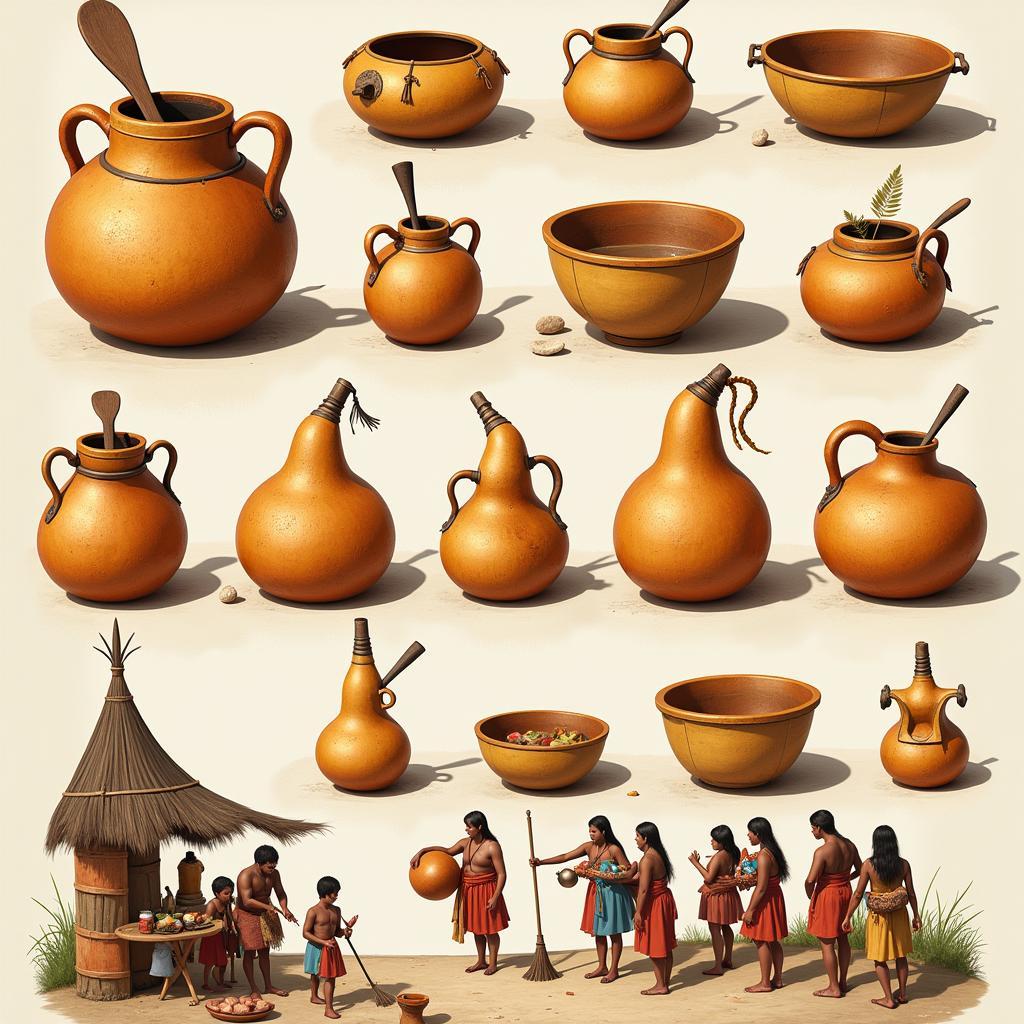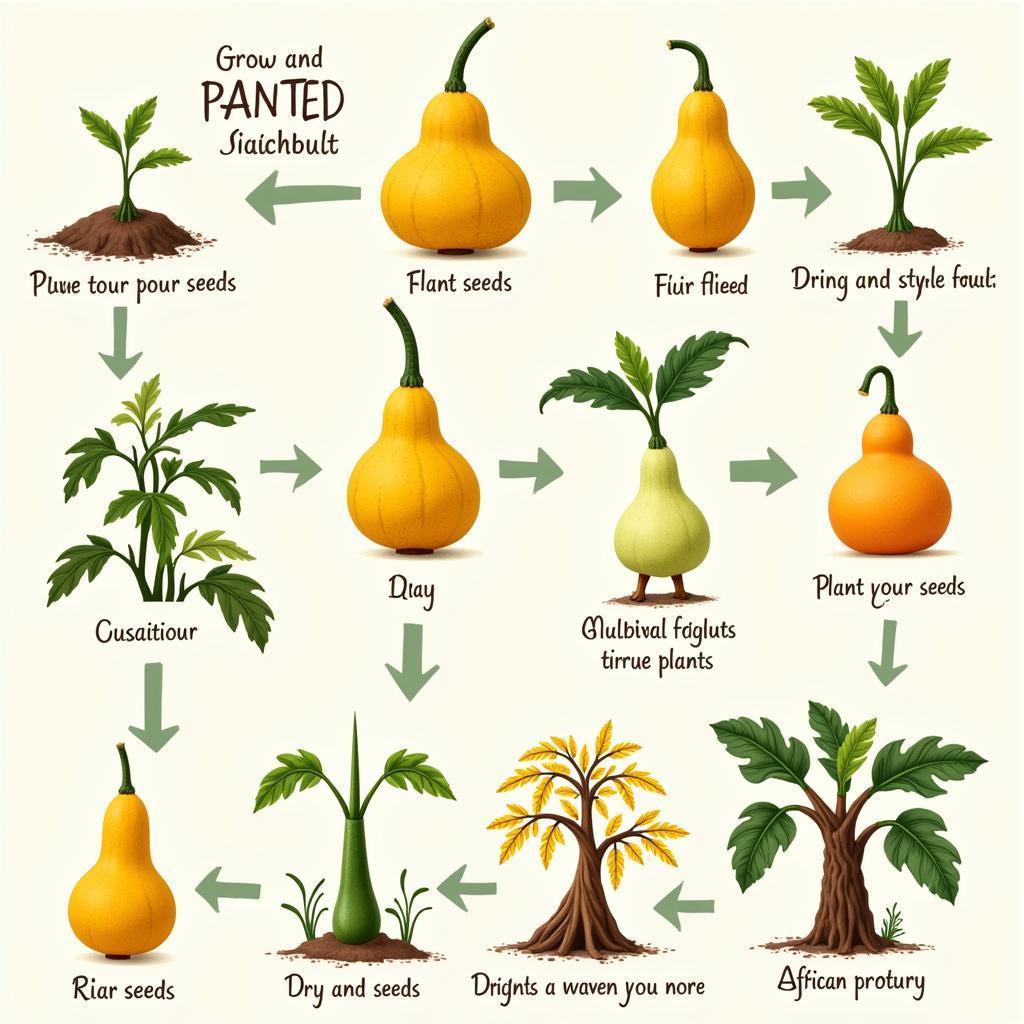Exploring the Versatile World of the African Gourd
The African Gourd is more than just a simple fruit; it’s a cornerstone of culture, a canvas for artistic expression, and a testament to the ingenuity of African communities. From musical instruments to utilitarian tools, the gourd’s versatility has shaped life across the continent for centuries. This article delves into the multifaceted uses of the African gourd, exploring its significance in music, art, cuisine, and daily life. Let’s embark on this journey to uncover the rich history and enduring legacy of this remarkable plant.
A common sight across the diverse landscapes of Africa, the gourd’s adaptable nature has allowed it to flourish in various climates and terrains. Its hard outer shell, when dried and hollowed, becomes a remarkably durable and lightweight vessel. This characteristic has led to its widespread use in a myriad of applications. African cultures have harnessed the gourd’s unique properties to create everything from musical instruments and containers to intricate works of art. The gourd’s significance is deeply intertwined with the cultural fabric of many African communities. Learn about the African gourd drum here: african gourd drum.
The African Gourd in Music and Art
The resonant qualities of the dried gourd make it a natural choice for musical instruments. From the kora, a 21-stringed West African harp-lute, to various percussion instruments like shekeres and drums, the gourd provides a rich, earthy tone. These instruments play a vital role in traditional ceremonies, storytelling, and communal celebrations. Moreover, the gourd’s smooth surface serves as an ideal canvas for artistic expression. Intricate carvings, vibrant paintings, and decorative beadwork transform these humble vessels into stunning works of art, showcasing the creativity and skill of African artisans.
 African Gourd Instruments in Music and Culture
African Gourd Instruments in Music and Culture
From Kitchen to Ceremony: The Gourd’s Utilitarian Role
Beyond its artistic and musical applications, the African gourd plays a crucial role in everyday life. It serves as a practical container for storing water, food, and other essentials. Larger gourds are used as bowls and ladles, while smaller ones can be fashioned into drinking cups. In some cultures, the gourd also holds symbolic meaning in rituals and ceremonies. It can be used as a ceremonial vessel, a symbol of fertility, or even a burial container, reflecting the deep connection between the gourd and the cycle of life. Check out this article on African gourd instruments: african gourd instrument.
 African Gourd Utilitarian Uses in Daily Life
African Gourd Utilitarian Uses in Daily Life
The African Gourd: A Symbol of Sustainability
In a world increasingly focused on sustainability, the African gourd stands as a timeless example of resourcefulness. Its biodegradable nature makes it an environmentally friendly alternative to plastic and other synthetic materials. From its use as a natural container to its role as a musical instrument, the African gourd embodies the principles of sustainable living. Furthermore, the cultivation and processing of gourds often involve traditional methods passed down through generations, preserving cultural knowledge and fostering community engagement. Find more information on African bushel gourd seeds: african bushel gourd seeds.
Cultivating and Caring for the African Gourd
Cultivating African gourds is a relatively straightforward process. They thrive in warm climates with ample sunlight and well-drained soil. The seeds can be sown directly into the ground or started indoors and later transplanted. With proper care and regular watering, the gourd vines will flourish, producing an abundance of fruit. Once harvested, the gourds are dried and cured, a process that can take several months, depending on the size and thickness of the shell. This traditional method ensures the gourd’s durability and longevity, allowing it to be used for generations to come. Here’s an interesting link about African shakers: 110 african shaker mini.
 African Gourd Cultivation and Harvesting
African Gourd Cultivation and Harvesting
“The African gourd is a testament to the ingenuity and creativity of African cultures,” says Dr. Abeni Adebayo, ethnobotanist and expert on African plant uses. “Its versatility and adaptability have made it an essential part of life for countless generations.” Another expert, Professor Kwame Nkrumah, a renowned historian specializing in African art and culture, adds, “The artistic traditions surrounding the African gourd are a powerful expression of cultural identity and heritage.”
In conclusion, the African gourd is much more than a simple fruit; it’s a symbol of resilience, creativity, and sustainable living. From its role in music and art to its utilitarian applications in daily life, the African gourd has shaped African cultures for centuries and continues to hold a prominent place in the continent’s rich tapestry of traditions. Discover the magic of the African gourd and its enduring legacy. Read this fascinating African Cinderella story: african cinderella story.
FAQ
- What is an African gourd? It’s a versatile fruit used for various purposes, from instruments to utensils.
- How are gourds used in African music? They are used to make instruments like drums, shekeres, and koras.
- Are gourds used in African art? Yes, they are often carved, painted, and decorated.
- How are gourds used in everyday life in Africa? They serve as containers, bowls, ladles, and more.
- Are African gourds sustainable? Yes, they are biodegradable and promote sustainable practices.
- How can I grow an African gourd? Plant seeds in warm climates with well-drained soil and ample sunlight.
- How are African gourds prepared for use? They are dried and cured over several months.
Need support? Contact us 24/7:
Phone: +255768904061
Email: [email protected]
Address: Mbarali DC Mawindi, Kangaga, Tanzania.


